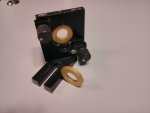You can determine the "exact" ratios by using the
luminous efficacy values for different wavelengths, which correspond to how bright your eye perceives certain wavelengths.
To get the ratios, you find the values of the wavelengths, for example (just using round numbers for wavelengths):
(R,G,B) = (640, 530, 450)nm --> (0.175, 0.862, 0.038)V_lambda
The normalized ratio values would be:
(0.175, 0.862, 0.038) / (0.175 + 0.862 + 0.038)
= (0.163, 0.802, 0.035)
Invert the values:
(6.143, 1.247, 28.29)
Normalize w.r.t. green:
(4.926, 1, 22.69) ~ 5:1:23
It's a pretty big ratio difference between green and the other colors.
Keep in mind that the ratio is not set in stone. The efficacy values are taken from photopic vision (daylight). When you're looking at laser beams/dots you're more in a mesopic vision regime, where you have high contrast dark areas and areas of brightness. The ratio will therefore be highly subjective.
A lot of the time your ratio will depend on what your limiting channel's power is. If you can't supply a whole lot of red, you'll have to tone down the green and blue. Likewise if you have tons of blue. Often you'll have enough green for your needs. Sometimes choosing a different wavelength can have dramatic differences in brightness (e.g. 462 vs 445); so you'll have to compensate.
For (638, 520, 455)nm I'd first try 4:1:8 and then adjust as needed. Some of the ratios you'll find on the net are using (635,532,473)nm wavelengths which have different brightness ratios than the wavelengths you're using. Again, it's pretty subjective and even "off" ratios can look pretty good.








